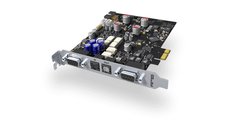RME introduces the HDSPe AIO Pro PCI Express interface card, the successor of the popular HDSPe AIO. The Pro version provides professional users in the fields of studio and broadcast with the same high channel count as well as analog/digital input and output variety of the HDSPe AIO. In terms of technical features RME has completely reworked the HDSPe AIO Pro, defining the current state-of-the-art in PCI Express cards.
Overview
Connectivity and Features
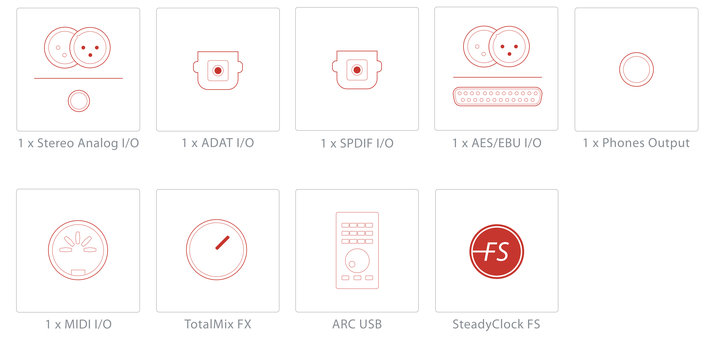
All inputs and outputs are simultaneously operational, even SPDIF (phono) and AES/EBU (XLR). Of course TotalMix, the unsurpassed flexible routing mixer and SteadyClock FS, RME's sensational clock technology with maximum jitter suppression of external clock signals, are on board too. HDSPe AIO Pro also supports the optional TCO for synchronization to timecode (LTC/video).
The new HDSPe AIO Pro is based on the reference processors AK5572 and AK4490 derived from the high-end AD/DA converter ADI-2 Pro. The analog input range also uses the circuit design of the ADI-2 Pro (+24 / +19 / +13 / +4 dBu). In addition, RME has enhanced the outputs with additional reference levels (balanced: +24 / +19 / +13 / +4 dBu; unbalanced: +19 / +13 / +4 / -2 dBu) which allows even more versatile integration into audio systems. The HDSPe AIO Pro features a dedicated attenuator in the output section, resulting in an increased signal-to-noise ratio and a lower output impedance at low reference levels.
A further highlight of the HDSPe AIO Pro is the newly developed, powerful and extremely transparent headphone output. Thanks to mute relay including switchable output levels, there is no unwanted crackling noise at the headphone output and the analog XLR and RCA outputs when switching on the computer.
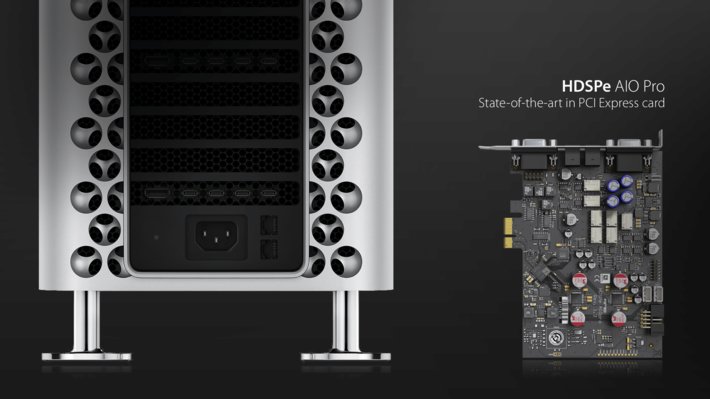
HDSPe AIO Pro -The completely reworked successor of the popular HDSPe AIO.
The HDSPe AIO Pro provides unique features:
- Balanced* stereo analog in- and output, 24-bit/192kHz
- All analog I/Os capable of 192 kHz, constant number of available channels
- All analog I/Os capable of 192 kHz, constant number of available channels
- 1 ADAT digital I/O, supporting 192 kHz via S/MUX4 operation
- 1 SPDIF digital I/O, 192 kHz-capable
- 1 AES/EBU digital I/O, 192 kHz-capable
- 1 High Power Headphone Output, separate DA-converter and playback device
- 1 MIDI I/O with 16 channels of hi-speed MIDI via breakout cable
- DIGIcheck - RME's unique metering- and analysing tool
- TotalMix FX: 760 channel Mixer with 42 bit internal resolution
- Native PCI Express - no PCI to PCI Express bridge used
- Outputs with Mute Relais
- +24 dBu I/O Levels
* The HDSPe AIO Pro ships in a basic version with analog RCA/phono breakout cables (headphone: TRS jack). Therefore all analog I/Os are unbalanced. An analog XLR breakout cable is available as option (headphone: Neutrik TRS locking jack), turning analog into balanced mode.
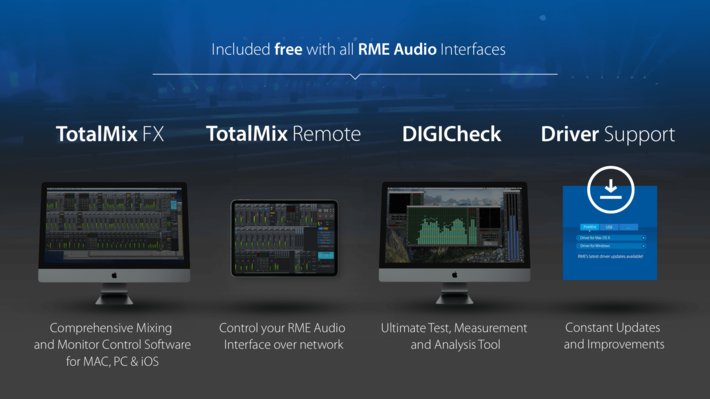
SteadyClock FS - Reference class Digital Clocking
In digital audio, the clock frequency is an essential factor, as it creates the correlation between the audio bits and the time reference. Unfortunately, the clock frequency is not always as stable as desired. The HDSPe AIO Pro offers full SteadyClock FS performance for lowest jitter and highest jitter immunity.
Excellent performance in all clock modes and High Quality Analog Conversion to hear your mix as it is. Digital format conversion in RME products are done without any loss or degredation,and SteadyClock FS ensures your sonic image will never experience degredation. This helps to optimize recordings and mixes because the soundstage has more depth and clarity.
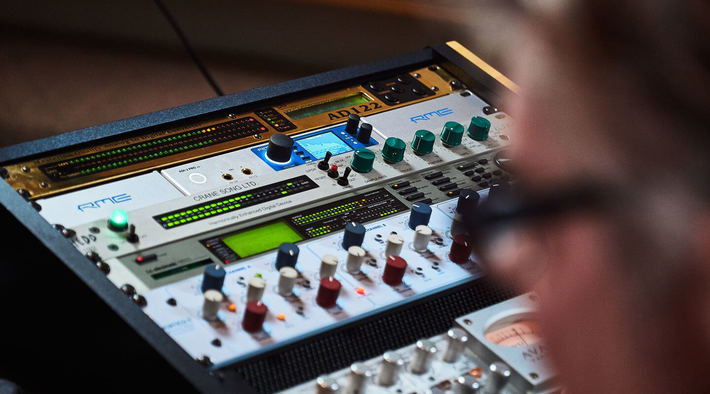
SteadyClock FS Technology from the countless award winning ADI-2 Series
Accessories
- BO9632XLRMKH: Analog XLR Breakout cable (XLR, MIDI, Phones)
- BO9632CMKH: Analog RCA Breakout cable (RCA, MIDI, Phones)
- BO9632: Digital RCA Breakout cable
- BO968: Digital XLR / RCA Breakout cable
- OK0100PRO: Optical cable, TOSLINK, 1 m (3.3 ft)
- OK0200PRO: Optical cable, TOSLINK, 2 m (6.6 ft)
- OK0300PRO: Optical cable, TOSLINK, 3 m (9.9 ft)
- ARC-USB: Advanced Remote Control for TotalMix FX
Word Clock Module (WCM)
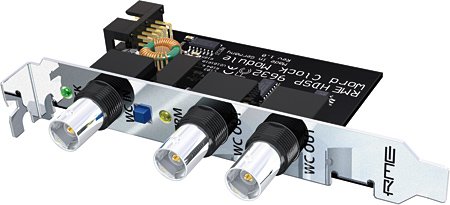
The Word Clock Module (WCM) provides a galvanically isolated word clock input and two word clock outputs (BNC connectors). Both outputs have their own driver stages, providing an extremely low jitter signal. A push switch activates 75 Ohms termination for the hi-impedance input. SteadyClock, part of the PCI card, guarantees an excellent performance in all clock modes. Its highly efficient jitter suppression refreshes and cleans up any clock signal, and provides it as reference clock at the two outputs.
Installation is done in a convenient manner using the supplied bracket. No PCI slot on the motherboard is required. The module is internally connected via a 10-pin connector and a flat ribbon cable to the PCI card. Thanks to several LEDs (power, termination, LOCK) and the highly integrated concept of installation, first operation and usage are simple even for the inexperienced user.
More information could be found in the HDSP 9632 WCM manual.
Tech Specs
RCA (Default D-sub Breakout cable)
- Input: RCA, unbalanced
- Input impedance: 18 kOhm
- Input sensitivity switchable +24 dBu, +19 dBu, +13 dBu, +4 dBu @ 0 dBFS
- Signal to Noise ratio (SNR) @ +19/24 dBu: 117 dB RMS unweighted, 120 dBA
- Signal to Noise ratio (SNR) @ +13 dBu: 116 dB RMS unweighted, 118 dBA
- Signal to Noise ratio (SNR) @ +4 dBu: 112 dB RMS unweighted, 114 dBA
- Frequency response @ 44.1 kHz, -0.1 dB: 7 Hz – 20.5 kHz
- Frequency response @ 96 kHz, -0.5 dB: 3 Hz – 45.5 kHz
- Frequency response @ 192 kHz, -1 dB: 2 Hz – 92 kHz
- THD @ -1 dBFS: -114 dB, 0.0002 %
- THD+N @ -1 dBFS: -110 dB, 0.0003 %
- Channel separation: > 110 dB
As RCA, but:
- Input: XLR, servo-balanced
- Input impedance balanced: 36 kOhm, unbalanced: 18 kOhm
- Signal to Noise ratio (SNR) @ +4 dBu: 116 dB RMS unweighted, 118 dBA
RCA (Default D-sub Breakout cable)
- Output: RCA, unbalanced
- Output impedance +19/+13 dBu: 75 Ohm. +4/-2 dBu: 80 Ohm
- Output level switchable +19 dBu, +13 dBu, +4 dBu, -2 dBu @ 0 dBFS
- Signal to Noise ratio (SNR) @ +19 dBu: 117 dB RMS unweighted, 119 dBA
- Signal to Noise ratio (SNR) @ +13 dBu: 116 dB RMS unweighted, 118 dBA
- Signal to Noise ratio (SNR) @ +4 dBu: 114 dB RMS unweighted, 116 dBA
- Signal to Noise ratio (SNR) @ -2 dBu: 110 dB RMS unweighted, 112 dBA
- Frequency response @ 44.1 kHz, -0.1 dB: 10 Hz – 20.2 kHz
- Frequency response @ 96 kHz, -0.5 dB: 4 Hz – 44.6 kHz
- Frequency response @ 192 kHz, -1 dB: 3 Hz – 83 kHz
- THD @ 0 dBFS: < -107 dB, 0.0005 %
- THD+N @ 0 dBFS: -105 dB, 0.0006 %
- Channel separation: > 110 dB
As RCA, but:
- Output: XLR
- Output impedance +24/+19 dBu: 150 Ohm. +13/+4 dBu: 160 Ohm
- Output level switchable +24 dBu, +19 dBu, +13 dBu, +4 dBu @ 0 dBFS
- Signal to Noise ratio (SNR) @ +24 dBu: 117 dB RMS unweighted, 120 dBA
As RCA, but:
- Output: 6.3 mm TRS jack, unbalanced, stereo
- Output impedance: 0.1 Ohm
- Signal to Noise ratio (SNR) @ +19 dBu (Hi-Power): 117 dB RMS unweighted, 119 dBA
- Signal to Noise ratio (SNR) @ +7 dBu (Lo-Power): 113 dB RMS unweighted, 115 dBA
- Output level at 0 dBFS, Hi-Power, load 150 Ohm or up: +19 dBu (6.9 V)
- Output level at 0 dBFS, Lo-Power, load 16 Ohm or up: +7 dBu (1.73 V)
- THD+N @ + 15 dBu, 32 Ohm load, 590 mW: -97 dB, 0.0016 %
- Max power @ 0.1% THD 32 Ohm: 730 mW per channel
AES/EBU
- 1 x XLR, transformer-balanced, galvanically isolated, according to AES3-1992
- High-sensitivity input stage (< 0.3 Vpp)
- SPDIF compatible (IEC 60958)
- Accepts Consumer and Professional format, copy protection will be ignored
- Lock range: 28 kHz – 200 kHz
- 1 x RCA, transformer-balanced, according to IEC 60958
- High-sensitivity input stage (< 0.3 Vpp)
- AES/EBU compatible (AES3-1992)
- Accepts Consumer and Professional format, copy protection will be ignored
- Lock range: 28 kHz – 200 kHz
- 1 x TOSLINK, format according to Alesis specification
- Standard: 8 channels 24 bit, up to 48 kHz
- Double Speed (S/MUX): 4 channels 24 bit 96 kHz
- Quad Speed (S/MUX4): 2 channels 24 bit 192 kHz
- Bitclock PLL ensures perfect synchronisation even in varispeed operation
- Lock range: 31.5 kHz – 50 kHz
AES/EBU
- 1 x XLR, transformer-balanced, galvanically isolated, according to AES3-1992
- Output level 4.0 Vpp
- Format Professional according to AES3-1992 Amendment 4
- Single Wire mode, sample rate 28 kHz up to 200 kHz
- 1 x RCA, transformer-balanced, according to IEC 60958
- Output level Professional 2.3 Vpp, Consumer 1.0 Vpp
- Format Professional according to AES3-1992 Amendment 4
- Format Consumer SPDIF according to IEC 60958
- Single Wire mode, sample rate 28 kHz up to 200 kHz
ADAT
- 1 x TOSLINK, format according to Alesis specification
- Standard: 8 channels 24 bit, up to 48 kHz
- Double Speed (S/MUX): 4 channels 24 bit 96 kHz
- Quad Speed (S/MUX4): 2 channels 24 bit 192 kHz
- Clocks: Internal, ADAT In, SPDIF In, AES In, Sync In, optional word clock / LTC In
- Jitter suppression of external clocks: > 50 dB (2.4 kHz)
- Effective clock jitter influence on AD and DA conversion: near zero
- PLL ensures zero dropout, even at more than 100 ns jitter
- Digital Bitclock PLL for trouble-free varispeed ADAT operation
- Supported sample rates: 28 kHz up to 200 kHz
- 1 x MIDI I/O via 5-pin DIN jacks
- Galvanically isolated by optocoupled input
- Hi-speed mode: Jitter and response time typically below 1 ms
- Separate 128 byte FIFOs for input and output


